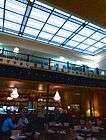The Woolwich
The Woolwich Equitable Building Society (later Woolwich Building Society or The Woolwich) was a United Kingdom financial institution owned by its members as a mutual organization. In 1997 it demutualised and became Woolwich PLC. The company was listed on the London Stock Exchange. It was once a constituent of the FTSE 100 Index but was acquired by Barclays in 2000.
| Public limited company | |
| Industry | Financial services |
| Fate | Merged with parent |
| Founded | 1847 |
| Headquarters | London, United Kingdom |
| Products | Mortgages |
| Parent | Barclays |
| Website | Barclays Group Archives: The Woolwich |
History
The Society was founded in Woolwich in 1847 as the Woolwich Equitable Benefit Building and Investment Association, one of the first permanent building societies.[1] Previously it had been active as a temporary society since 1842. Its establishment constituted an important stage in the history of mutualism in Woolwich (see: Royal Arsenal Co-operative Society).[2]
The Woolwich was one of the largest UK building societies and was famous in the 1980s for its entertaining TV advertising incorporating the slogan "I'm with the Woolwich".[3]
From 1984 to 1992, The Woolwich sponsored Charlton Athletic F.C. at a time that included their departure from the outdated Valley stadium in September 1985 (they returned in December 1992, by which time the stadium had been rebuilt) and the club's promotion to the Football League First Division the following May, continuing for two years after the relegation in 1990.[4]
The Woolwich Equitable Building Society demutualised in 1997, giving up its mutual status to become a bank: Woolwich PLC was formed, giving shares to investing and borrowing members of the society, and listing on the London Stock Exchange.[5]
In August 2000, Barclays took over Woolwich PLC in a £5.4bn acquisition. Woolwich PLC thus joined the Barclays Bank Group of companies. The Woolwich brand-name was retained after the acquisition, and the Woolwich head office remained in Bexleyheath, south-east London, 4.5 mi from the original office in Woolwich.[6]
On 28 June 2006, Barclays announced that The Woolwich was to become the Barclays UK mortgage brand, supported by Barclays branches, and that Woolwich branches would be either closed or re-branded as Barclays.[7]
Associated changes to call centres affected up to 1,200 jobs, mostly at The Woolwich contact centre in Clacton-on-Sea, which closed at the end of 2007.[8]
Although the Woolwich name lived on as the brand used for Barclays mortgages, this was discontinued in 2015.[9]
Headquarters
The Woolwich Equitable Building Society started in Powis Street, Woolwich, where it occupied various premises. From 1896 until 1935 it was headquartered at a purpose-built corner office at 111-113 Powis Street, after which it moved to larger premises at Eakes Place, now Equitable House at General Gordon Square. In 1989 it moved to new headquarters in nearby Bexleyheath, alongside the society's main administration and computer centre which had been based at the corner of Watling Street and Erith Road for many years. Following the takeover by Barclays, the Bexleyheath head office closed in 2005.[10] In 2014 the Woolwich's former Head Office became the Civic Offices of Bexley London Borough Council.[11]
Equitable House continued as a branch office until 2007. In 2010–11 it was converted into a commercial building by Sundridge Investments, with a pub, a cafe and shops on the ground floor, and the upper floors rented out to Maritime Greenwich College, later South London College.[12]
.jpg) Powis Street HQ, 1847-1896
Powis Street HQ, 1847-1896 Powis Street HQ, 1896-1935 (the corner building)
Powis Street HQ, 1896-1935 (the corner building) Equitable House HQ, 1935-1989
Equitable House HQ, 1935-1989 Banking hall Equitable House, now a pub
Banking hall Equitable House, now a pub
References
- The Woolwich archives
- Saint, A., Guillery, P. (ed.), Woolwich – Survey of London, Volume 48, pp. 204-205. Yale Books, London, 2012. ISBN 978 0 300 18722 9
- I'm with the Woolwich Archived 2009-11-12 at the Wayback Machine CorporateComms, 1 February 2007
- "Charlton Athletic". Historical Football Kits. Archived from the original on 15 May 2008. Retrieved 16 June 2008.
- Woolwich PLC's a-1 rating affirmed by S&P Business wire, 7 July 1997
- Barclays buys rival Woolwich BBC News, 11 August 2000
- Fears that up to 200 branches will close in Barclays' rebranding of Woolwich Guardian, 29 June 2006
- Barclays to cut 1,200 positions BBC News, 28 June 2006
- Barclays pulls the plug on Woolwich brand FT Advisor, 21 July 2015
- Fowler, Joshua. "Redevelopment of former Woolwich building in Bexleyheath approved". Bexley Times, 17 July 2012. Retrieved 5 September 2012.
- Woolwich Building Society on bexley.gov.uk, visited on 23-02-2017
- Saint & Guillery (2012), pp. 237-240
External links
| Wikimedia Commons has media related to Woolwich Equitable Building Society (The Woolwich). |